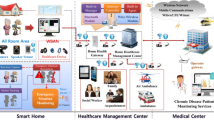Abstract
Information access and retrieval from cloud resources in an Internet of Things (IoT) paradigm is a challenging task due to synchronization and availability issues. IoT devices and user equipment access resources in a ubiquitous manner irrespective of time and resource availability. To address the synchronization issues in resource availability and accessibility, this article introduces reliable service availability and access control (RSA2C) method. In this method, the available resources are scheduled for serving incoming requests on the basis of service time. Prior to the scheduling process, the requests are classified as overlapping and non-overlapping to reduce delays and backlogs. The gateway accessibility process is capable of accepting and processing incoming requests by evaluating the minimum processing time to select a reliable gateway. This time-based selection aids in improving the response rate. The occupancy factor of the gateway is estimated for admitting requests to the cloud layer. A specific weight factor is used for differentiating gateways on the basis of cost and occupancy factor, to improve the accuracy of selection. The non-overlapping requests are handled using optimal gateways and the other requests are processed in a recurrent manner. As the request processing follows sequential processing recurrently, the delay in transmission and drops i.e. the backlogs are prevented. The distinct methods are incorporated in the gateway and cloud layers for achieving reliable communication estimated using the metrics bandwidth, resource utilization ratio, pause time, delay and backlogs.









Similar content being viewed by others
References
Musaddiq, A., Zikria, Y. B., Hahm, O., Yu, H., Bashir, A. K., & Kim, S. W. (2018). A survey on resource management in IoT operating systems. IEEE Access, 6, 8459–8482.
Munoz, R., Vilalta, R., Yoshikane, N., Casellas, R., Martinez, R., Tsuritani, T., et al. (2018). Integration of IoT, transport SDN, and edge/cloud computing for dynamic distribution of IoT Analytics and efficient use of network resources. Journal of Lightwave Technology, 36(7), 1420–1428.
Ning, H., & Hu, S. (2012). Technology classification, industry, and education for Future Internet of Things. International Journal of Communication Systems, 25(9), 1230–1241.
Anandakumar, H., & Umamaheswari, K. (2017). Supervised machine learning techniques in cognitive radio networks during cooperative spectrum handovers. Cluster Computing, 20(2), 1505–1515.
Carvalho, M., Cirne, W., Brasileiro, F., & Wilkes, J. (2014). Long-term SLOs for reclaimed cloud computing resources. In Proceedings of the ACM symposium on cloud computing—SOCC 14.
Jiang, F., Liu, Y., Wang, B., & Wang, X. (2017). A relay-aided device-to-device-based load balancing scheme for multitier heterogeneous networks. IEEE Internet of Things Journal, 4(5), 1537–1551.
Deng, Y., Chen, Z., Zhang, D., & Zhao, M. (2018). Workload scheduling toward worst-case delay and optimal utility for single-hop Fog-IoT architecture. IET Communications, 12(17), 2164–2173.
Mubeen, S., Nikolaidis, P., Didic, A., Pei-Breivold, H., Sandstrom, K., & Behnam, M. (2017). Delay mitigation in offloaded cloud controllers in industrial IoT. IEEE Access, 5, 4418–4430.
Mubeen, S., Asadollah, S. A., Papadopoulos, A. V., Ashjaei, M., Pei-Breivold, H., & Behnam, M. (2018). Management of service level agreements for cloud services in IoT: A systematic mapping study. IEEE Access, 6, 30184–30207.
Metzger, F., Hobfeld, T., Bauer, A., Kounev, S., & Heegaard, P. E. (2019). Modeling of aggregated IoT traffic and its application to an IoT cloud. Proceedings of the IEEE, 107(4), 679–694.
Li, X., Lian, Z., Qin, X., & Jie, W. (2018). Topology-aware resource allocation for IoT services in clouds. IEEE Access, 6, 77880–77889.
Chen, X., Tang, S., Lu, Z., Wu, J., Duan, Y., Huang, S.-C., et al. (2019). iDiSC: A new approach to IoT-data-intensive service components deployment in edge-cloud-hybrid system. IEEE Access, 7, 59172–59184.
Thangapandian, M., Anand, P. M. R., & Sankaran, K. S. (2018). Enhanced cloud security implementation using modified ECC algorithm. In 7th IEEE international conference on communication and signal processing, ICCSP 2018 (pp. 1019–1022).
Pejanovic-Djurisic, M., Kocan, E., & Ilic-Delibasic, M. (2012). Energy efficient wireless communications through cooperative relaying. Journal of Green Engineering, 3(1), 71–90.
Filip, I.-D., Pop, F., Serbanescu, C., & Choi, C. (2018). Microservices scheduling model over heterogeneous cloud-edge environments as support for IoT applications. IEEE Internet of Things Journal, 5(4), 2672–2681.
Stavrinides, G. L., & Karatza, H. D. (2018). A hybrid approach to scheduling real-time IoT workflows in fog and cloud environments. Multimedia Tools and Applications, 78(17), 24639–24655.
Kotb, Y., Ridhawi, I. A., Aloqaily, M., Baker, T., Jararweh, Y., & Tawfik, H. (2019). Cloud-based multi-agent cooperation for IoT devices using workflow-nets. Journal of Grid Computing. https://doi.org/10.1007/s10723-019-09485-z.
Khansari, M. E., Sharifian, S., & Motamedi, S. A. (2018). Virtual sensor as a service: A new multicriteria QoS-aware cloud service composition for IoT applications. The Journal of Supercomputing, 74(10), 5485–5512.
Righi, R. D. R., Correa, E., Gomes, M. M., & Costa, C. A. D. (2018). Enhancing performance of IoT applications with load prediction and cloud elasticity. Future Generation Computer Systems. https://doi.org/10.1016/j.future.2018.06.026.
Tao, M., Zuo, J., Liu, Z., Castiglione, A., & Palmieri, F. (2018). Multi-layer cloud architectural model and ontology-based security service framework for IoT-based smart homes. Future Generation Computer Systems, 78, 1040–1051.
Chen, J., & Wang, Y. (2019). A hybrid method for short-term host utilization prediction in cloud computing. Journal of Electrical and Computer Engineering, 2019, 1–14.
Author information
Authors and Affiliations
Corresponding author
Additional information
Publisher's Note
Springer Nature remains neutral with regard to jurisdictional claims in published maps and institutional affiliations.
Rights and permissions
About this article
Cite this article
Kousalya, A., Sakthidasan, K. & Latha, A. Reliable service availability and access control method for cloud assisted IOT communications. Wireless Netw 27, 881–892 (2021). https://doi.org/10.1007/s11276-019-02184-3
Published:
Issue Date:
DOI: https://doi.org/10.1007/s11276-019-02184-3




